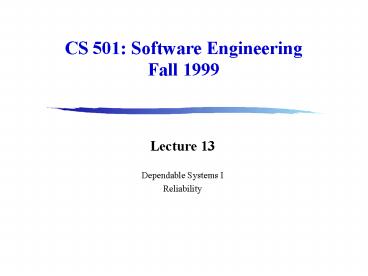CS 501: Software Engineering Fall 1999 - PowerPoint PPT Presentation
Title:
CS 501: Software Engineering Fall 1999
Description:
Hypothetical example: Cars are safer than airplane in ... Example: Dartmouth Time Sharing (1980) A central computer serves ... Time Sharing (1980) ... – PowerPoint PPT presentation
Number of Views:33
Avg rating:3.0/5.0
Title: CS 501: Software Engineering Fall 1999
1
CS 501 Software EngineeringFall 1999
Lecture 13 Dependable Systems I Reliability
2
Administration
? Extension of due date for Assignment 3. ?
Final examination Objective To test the
material presented in the lectures
and in the readings Date
Coming shortly
3
Assignment 2
Lessons for Software Engineering ? Time reported
from 1.5 to 15 hours (110). ? Choice between
doing it on time or doing it right! ? Different
people have different skills (programming v.
report writing).
4
Assignment 2
Where does the time go? 1. Getting started --
software and hardware, loading the sources,
building the system 2. Design and programming 3.
Blind alleys 4. Troubles, bugs, testing 5.
Reporting and documentation Item 2 was typically
less than 25 of reported effort
5
Assignment 2 Report Writing
? Good reports need not be long ? Presentation
is important ? Details matter Title, author
name, date Spelling and grammar (use spelling
checker) ? Some look professional some look
amateur Final project presentations must be
professional.
6
Software Reliability
Fault Programming or design error whereby the
delivered system does not conform to
specification Failure Software does not deliver
the service expected by the user. Reliability
Probability of an error occurring in operational
use. Perceived reliability Depends upon user
behavior set of inputs pain of failure
7
Reliability Metrics
? Probability of failure on demand ? Rate of
failure occurrence (failure intensity) ? Mean
time between failures ? Availability (up time) ?
Mean time to repair ? Distribution of
failures Hypothetical example Cars are safer
than airplane in accidents (failures) per hour,
but less safe in failures per mile.
8
Reliability Metrics for Distributed Systems
Traditional metrics are hard to apply in
multi-component systems ? In a big network, at
a given moment something will be giving trouble,
but very few users will see it. ? A system that
has excellent average reliability may give
terrible service to certain users. ? There are
so many components that system administrators
rely on automatic reporting systems to identify
problem areas.
9
User Perception of Reliability
1. A personal computer that crashes frequently
v. a machine that is out of service for two
days. 2. A database system that crashes
frequently but comes back quickly with no loss of
data v. a system that fails once in three years
but data has to be restored from backup. 3. A
system that does not fail but has unpredictable
periods when it runs very slowly.
10
Cost of Improved Reliability
Up time
100
99
Will you spend your money on new functionality or
improved reliability?
11
Specification of System Reliability
Example ATM card reader
Failure class Example Metric Permanent
System fails to operate 1 per 1,000
days non-corrupting with any card --
reboot Transient System can not read 1 in
1,000 transactions non-corrupting an undamaged
card Corrupting A pattern of Never
transactions corrupts database
12
Statistical Testing
? Determine the operational profile of the
software ? Select or generate a profile of test
data ? Apply test data to system, record failure
patterns ? Compute statistical values of metrics
under test conditions
13
Statistical Testing
Advantages ? Can test with very large numbers
of transactions ? Can test with extreme cases
(high loads, restarts, disruptions) ? Can repeat
after system modifications Disadvantages ?
Uncertainty in operational profile (unlikely
inputs) ? Expensive ? Can never prove high
reliability
14
Example Dartmouth Time Sharing (1980)
A central computer serves the entire campus. Any
failure is serious. Step 1. Gather data on
every failure ? 10 years of data in a simple
data base ? Every failure analyzed hardware so
ftware (default) environment (e.g., power, air
conditioning) human (e.g., operator error)
15
Example Dartmouth Time Sharing (1980)
Step 2. Analyze the data. ? Weekly, monthly,
and annual statistics Number of failures and
interruptions Mean time to repair ? Graphs of
trends by component, e.g., Failure rates of disk
drives Hardware failures after power
failures Crashes caused by software bugs in each
module
16
Example Dartmouth Time Sharing (1980)
Step 3. Invest resources where benefit will be
maximum, e.g., ? Orderly shut down after power
failure ? Priority order for software
improvements ? Changed procedures for
operators ? Replacement hardware
17
Some Notable Bugs
? Built-in function in Fortran compiler (e0
0) ? Japanese microcode for Honeywell DPS
virtual memory ? The microfilm plotter with the
missing byte (11023) ? The Sun 3 page fault
that IBM paid to fix ? Left handed rotation in
the graphics package Good people work around
problems. The best people track them down and fix
them!































